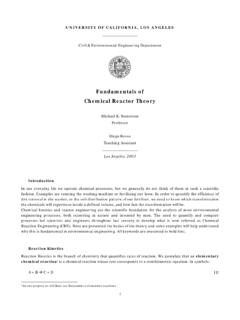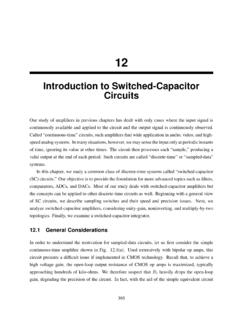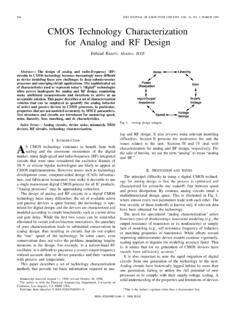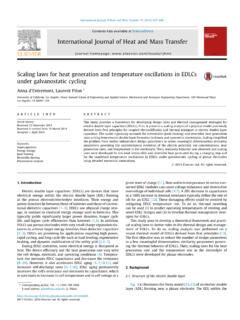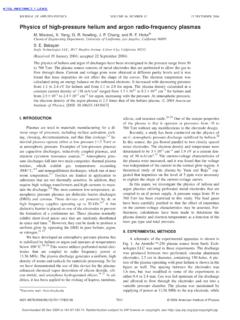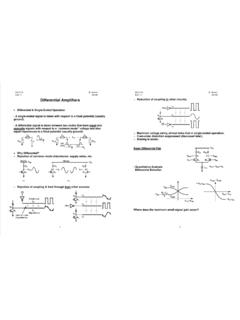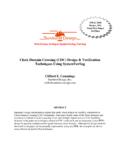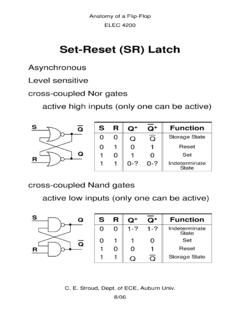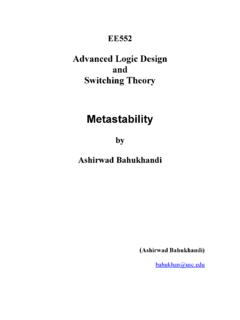Transcription of The Design of a Comparator [The Analog Mind]
1 8 FALL 2020 IEEE SOLID-STATE CIRCUITS MAGAZINE THE Analog MINDB ehzad RazaviNNyquist-rate and oversampling ana-log-to-digital converters (ADCs) in-corporate comparators to perform quantization and possibly sampling. Comparators thus have a significant impact on the speed and precision of ADCs. This article presents the step-by-step Design of a compara-tor and the discovery of its various ConsiderationsA Comparator senses a differential input and generates a logical output according to the polarity of the input difference. In an ADC environment, we are interested in the following Comparator Design parameters: in-put offset, speed, power consump-tion, metastability , kickback noise, and input-referred electronic noise.
2 The Design begins with the selection of target values for some of these pa-rameters. Here, we aim for an input offset lower than 5 mV; a clock rate, fCK, of 5 GHz; and a power consump-tion of 1 mW. After the Design meets these requirements, we examine the remaining parameters and decide whether they are this article, we selected the StrongArm latch as the Comparator core. Readers are referred to [1] [4] for the properties and operation de-tails of the circuit. Shown in Figure 1, this topology offers several desir-able attributes: it requires a single-clock phase; draws no static power; exhibits an input offset that arises primarily from the input pair, M1 and M2; and delivers rail-to-rail out-put swings [4].
3 A brief overview of the Strong-Arm latch s operation proves helpful here. As explained in [4], the circuit of Figure 1 begins by precharging nodes P, Q, X, and Y to VDD. We denote the capacitances at these nodes by ,,,CCCPQX and CY, respectively, and assume that CCPQ= and .CCXY= When CK goes high, M1 and M2 act as a differential pair with capacitive loads, and VP and VQ fall from VDD while yielding a differential compo-nent proportional to .VV12inin- This mode continues until VP and VQ drop to roughly ,VV3,4 DDTH- creating a voltage gain approximately equal to /,gVI2,m123,4 THSS where g,m12 denotes the transconductance of M1 and M2, and ISS is the tail current [3].
4 At the end of this mode, M3 and M4 turn on, causing VX and VY to fall until M5 and M6 are activated. One output is then pulled back to VDD by M5 or M6 while the other falls to zero. As ex-amined in [4], the role of M3 and M4 is to cut the current path from VDD to the ground after the Comparator has made a decision. The circuit s power consumption in the signal path is given by fCVfCV2PX22 CKDDCKDD+ [4]. Additionally, the clock path draws a power of ,fCV2 CKCKDD where CCK is the sum of the gate capacitances of M7 and the four PMOS switches, S1 precharge action in the StrongArm latch offers two benefits.
5 First, it enables VP and VQ in Figure 1 to begin from VDD, thus keeping M1 and M2 in saturation for some time. This allows the input transistors to provide gain. Second, after each comparison, the four internal nodes recover from the states developed on them and are equalized. This ensures that the states in one clock cycle are not inherited by the next, suppressing dynamic offsets. As depicted in Figure 2, if, at the end of the precharge mode, VP and VQ do not become exactly equal and bear a difference of ,VD the subsequent am-plification mode begins with such a difference stored on CP and CQ, suf-fering from Design of a ComparatorDigital Object Identifier of current version: 18 November 2020 VDDVDDVDD VTH5,6 CKCKCKS1S3S4S2M5M6M3M1M2M7M4 XYPQVoutVin1 Vin2 VPVYVXVQt1tFIGURE 1: The StrongArm latch and its waveforms.
6 IEEE SOLID-STATE CIRCUITS MAGAZINE FALL 2020 9 Most of our Design effort is ex-pended on selecting the transistor dimensions in Figure 1. We generally begin with near-minimum dimen-sions unless there is a compelling reason not to do so. Also, our simu-lations are performed under worst-case process, supply voltage, and temperature (PVT) conditions because the circuit must eventually oper-ate satisfactorily in such a corner.
7 In this spirit, we select the slow-slow corner, %. ,V15095 VVDD=-= and .T75Cc= We also assume for the clock a 50% duty cycle and 10-ps rise and fall times. The Comparator is de-signed using 28-nm CMOS technology. Choice of Device DimensionsComparator Design begins with se-lecting the transistor dimensions so as to meet the offset requirement. In our case, the pairs M1 and M2, M3 and M4, and M5 and M6 in Figure 1 ap-pear in the signal path and must be crafted first. Let us consider M1 and M2 and write their threshold voltage mismatch as (),VWLA,121,2 THVTHD= (1)where AVTH is a constant [5] and roughly mV m in 28-nm tech-nology.
8 If we choose W10m,12n= and an effective length of 25 nm, then . This appears to be a reasonable starting point pro-vided that the other pairs contribu-tions do not raise the offset beyond the 5-mV should remark that (1) gives the standard deviation, ,v of the mismatch; , approximately 68% of the differential pairs in a Gauss-ian distribution exhibit offsets less than this amount. In practice, we seek higher yields and must either enlarge the transistors or incorpo-rate offset tail transistor M7 in Figure 1 must draw sufficient current with VV7 GSDD= and ,VVV7,1,2 DSinCMGS=- where V,inCM denotes the input common-mode (CM) level.
9 With . V05V,inCM= and .,V035V,GS12. we have ..VV015DS7. The device thus operates in the deep triode region. Let us select W2m7n= for a current of roughly that the circuit provides gain before M3 and M4 turn on, we expect that the offset of this pair is reduced when referred to the main input. The reduction factor is, in fact, greater than the value of /gVI2,m123,4 THSS mentioned previously. To under-stand why, suppose M3 and M4 are on (Figure 3) and neglect the capacitanc-es at nodes P and Q. Thus, ID1 and ID2 entirely flow through M3 and M4, respectively, as if these transistors were absent.
10 The offset contributed by this pair is therefore negligible unless the circuit s capacitances are taken into account. As discussed lat-er in this section, the threshold mis-match between M3 and M4 is divided by a factor of 3 5 in typical designs. We select W10m,34n= for now, ex-pecting that this choice only slightly raises the input PMOS cross-coupled pair in Figure 1 turns on after VX and VY fall by one 1-PMOS threshold. Before this time, the circuit provides a high voltage gain, thereby reducing this pair s offset contribution consid-erably. In this respect, we surmise that a width of a few microns suf-fices for M5 and M6, but we must bear in mind that these devices also amplify regeneratively and play a role in the Comparator s speed.
